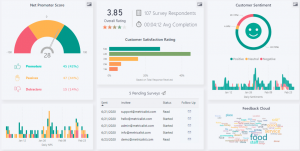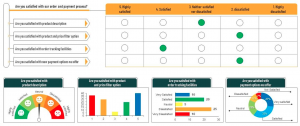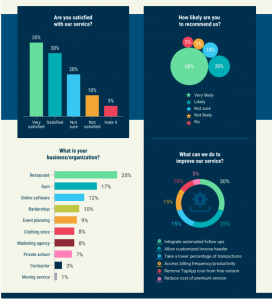In today’s hyper-competitive business landscape, customer satisfaction isn’t just a buzzword – it’s the cornerstone of success. A well-crafted customer satisfaction report serves as a compass, guiding businesses towards understanding their clientele’s needs, preferences, and pain points. But what exactly is a customer satisfaction report, and how can businesses harness its power to drive growth and loyalty?
What is a Customer Satisfaction Report?
At its core, a customer satisfaction report is a comprehensive analysis of customer feedback, sentiments, and experiences with a particular product, service, or brand. It encapsulates various metrics such as Net Promoter Score (NPS), Customer Satisfaction Score (CSAT), and Customer Effort Score (CES) to provide a holistic view of customer satisfaction levels. This report acts as a roadmap for businesses, highlighting areas of strength to leverage and weaknesses to address.
Famous management consultant Peter Drucker once famously said, “The purpose of business is to create and keep a customer.” This succinctly captures the essence of a customer satisfaction report – it’s not just about acquiring customers but ensuring their long-term satisfaction and loyalty.

How Do You Write a Customer Satisfaction Report?
Writing a customer satisfaction report requires a structured approach and attention to detail. Begin by gathering data from various touchpoints, including surveys, reviews, social media, and customer service interactions. Next, categorize the feedback based on common themes or topics, such as product quality, customer support, or pricing.
Once you have organized the data, it’s time to analyze it thoroughly. Look for trends, patterns, and correlations that can provide valuable insights into customer preferences and pain points. Remember, the goal is not just to report the findings but also to derive actionable recommendations for improvement.
American business magnate and philanthropist, Bill Gates, once remarked, “Your most unhappy customers are your greatest source of learning.” This underscores the importance of not shying away from negative feedback but rather embracing it as an opportunity for growth and innovation.
How Do You Document Customer Satisfaction?
Documenting customer satisfaction involves more than just compiling data – it’s about creating a narrative that tells the story behind the numbers. Start by summarizing key findings and trends in a clear and concise manner. Use visual aids such as charts, graphs, and infographics to illustrate your points effectively.
Additionally, provide context around the findings by including customer quotes, testimonials, and anecdotes. This humanizes the data and makes it more relatable to stakeholders across the organization. Remember, the goal is to paint a vivid picture of the customer experience, from initial interaction to post-purchase support.
As renowned customer service expert Shep Hyken once said, “The magic formula that successful businesses have discovered is to treat customers like guests and employees like people.” This philosophy underscores the importance of empathy and human connection in documenting customer satisfaction.

How Do You Record Customer Satisfaction?
Recording customer satisfaction involves establishing robust systems and processes to capture feedback consistently across all touchpoints. Implement surveys, feedback forms, and rating systems at various stages of the customer journey to gather real-time insights.
Moreover, leverage technology solutions such as customer relationship management (CRM) software to centralize and analyze customer data efficiently. By recording customer satisfaction in a systematic manner, businesses can identify trends and track progress over time, enabling continuous improvement.
Renowned author Maya Angelou once famously said, “People will forget what you said, people will forget what you did, but people will never forget how you made them feel.” This quote encapsulates the essence of recording customer satisfaction – it’s not just about the transactional aspects but also the emotional impact of the experience.
What is Customer Satisfaction?
Customer satisfaction is the measure of how products or services provided by a company meet or surpass customer expectations. It encompasses various factors such as product quality, price, convenience, and customer service. Essentially, it reflects the overall experience and perception of a brand from the customer’s perspective.
For example, imagine a customer purchases a smartphone and finds it easy to use, durable, and reasonably priced. They receive prompt assistance from customer support when needed, further enhancing their satisfaction. In this scenario, customer satisfaction is high due to the positive experience across multiple touchpoints.
As American business magnate and founder of Ford Motor Company, Henry Ford, famously said, “It is not the employer who pays the wages. Employers only handle the money. It is the customer who pays the wages.” This quote underscores the fundamental principle that customer satisfaction is paramount to business success.

What is an Example of a Customer Satisfaction Question?
A common example of a customer satisfaction question is the Net Promoter Score (NPS) question: “On a scale of 0-10, how likely are you to recommend our product/service to a friend or colleague?” This question gauges the likelihood of customers becoming brand advocates based on their overall satisfaction.
Another example is the Customer Satisfaction Score (CSAT) question: “How would you rate your overall satisfaction with our product/service?” Respondents typically choose from options like “Very Satisfied,” “Satisfied,” “Neutral,” “Dissatisfied,” or “Very Dissatisfied,” providing a quantitative measure of satisfaction.
By incorporating such questions into surveys and feedback forms, businesses can gather valuable insights into customer sentiment and identify areas for improvement.
Customer Satisfaction Survey Report Analysis
Analyzing a customer satisfaction survey report involves delving deep into the data to uncover actionable insights. Start by examining key metrics such as NPS, CSAT, and CES to gauge overall satisfaction levels. Then, drill down into specific themes or topics to identify areas of strength and weakness.
For example, if the survey reveals a high NPS but low satisfaction scores for customer support, it indicates a disconnect between product quality and service experience. In such cases, businesses can prioritize training initiatives for support staff to improve the overall customer experience.
Additionally, look for correlations between demographic variables such as age, gender, and location to tailor strategies accordingly. For instance, if younger customers express dissatisfaction with the user interface, consider redesigning it to better meet their needs and preferences.
As business guru Warren Buffett famously said, “It takes 20 years to build a reputation and five minutes to ruin it.” This quote underscores the importance of proactive analysis and action based on customer satisfaction survey reports to safeguard brand reputation and foster long-term loyalty.

Customer Satisfaction Analysis
Customer satisfaction analysis involves synthesizing data from various sources to gain a comprehensive understanding of customer perceptions and behaviors. Start by segmenting customers based on factors such as demographics, purchase history, and engagement levels.
Next, conduct sentiment analysis on customer feedback to identify positive and negative sentiments towards the brand. This allows businesses to prioritize areas for improvement and capitalize on strengths to enhance overall satisfaction.
Moreover, leverage predictive analytics techniques to forecast future trends and anticipate customer needs. By staying ahead of the curve, businesses can proactively address potential issues and deliver personalized experiences that resonate with their target audience.
As marketing expert Philip Kotler once said, “The key to successful leadership today is influence, not authority.” This quote emphasizes the importance of listening to customers and using their feedback to drive strategic decision-making.

In conclusion, a well-executed customer satisfaction report is more than just a document – it’s a roadmap to success in today’s customer-centric business landscape. By understanding the nuances of writing, documenting, and analyzing customer satisfaction, businesses can unlock valuable insights and foster long-term loyalty. As the famous saying goes, “The customer is king,” and prioritizing their satisfaction is the key to reigning supreme in the market.